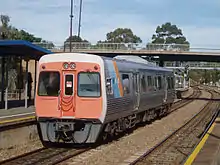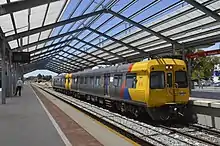3000 class railcar
The 3000 class and 3100 class are diesel railcars that operate on the Adelaide rail network. Built by Comeng and Clyde Engineering between 1987 and 1996, they entered service under the State Transport Authority before later being operated by TransAdelaide and Adelaide Metro. Trains are typically coupled as multiple units, though the 3000 class are also able to run as single units when needed.
| 3000 and 3100 class railcars | |
|---|---|
 3108/3109 at Kilkenny in November 2019 | |
.jpg.webp) Interior of a refurbished unit | |
| Manufacturer | Comeng, Clyde Engineering |
| Built at | Dandenong and Somerton, Victoria |
| Entered service | 1987–1996 |
| Refurbished | 2018 |
| Number built | 70 |
| Formation |
|
| Fleet numbers |
|
| Capacity |
|
| Operator(s) | |
| Depot(s) |
|
| Line(s) served | |
| Specifications | |
| Car length | 25.77 m (84 ft 7 in) |
| Width | 3.05 m (10 ft 0 in) |
| Height | 4.27 m (14 ft 0 in) |
| Maximum speed |
|
| Weight |
|
| Traction system | After repowering: ABB BORDLINE CC400 DE IGBT power converter[1] |
| Prime mover(s) |
|
| Traction motors | 2 × 130 kW (170 hp) ABB/Stromberg HXR315SC4B7E / HXUR/E632G2B7 |
| Power output |
|
| Transmission | Diesel-electric |
| UIC classification |
|
| Braking system(s) | Knorr-Bremse |
| Coupling system | Scharfenberg |
| Track gauge | 1,600 mm (5 ft 3 in) |
History

In March 1985, the State Transport Authority (STA) awarded a tender for 20 diesel railcars (eight 3000 class units with a cab at each end and twelve 3100 class with a cab at one end only) to Comeng's Dandenong rolling stock factory.[2][3][4] The design was based on the stainless steel shell of the Comeng electric train then in production for Melbourne's Public Transport Corporation, but 2.3 metres (7 ft 7 in) longer and with only two doors per side. Because of a contractual requirement to maximise local content, the fit out was conducted at Comeng's Dry Creek facility. The first commenced testing in May 1987, entering service in November 1987.[5][6] The eight 3000s were built first with the first 3100 class completed in mid-1988.[7][8][9] The last entered service in December 1988.[10]
In the original contract, there was an option to order 76 further examples. However Comeng came back to the STA with a significantly higher price, so the work was put out to tender and a contract for 50 awarded to Clyde Engineering in November 1989.[11] Comeng concluded a deal to sell the 3000 class design and tooling. However by the time construction commenced, Comeng had sold its Dandenong plant to ABB who backed away from an agreement to hand over the jigs and tooling, so they were built between 1992 and 1996 by Clyde Engineering's Martin & King factory in Somerton, Victoria.[9][12][13]
All were delivered with unpainted stainless steel offset by blue and orange stripes. In April 2002 the first was repainted by Bluebird Rail Operations in Adelaide Metro's yellow, blue and red.[14]
Originally they operated on all Adelaide suburban lines, however since the electrification of the Seaford and Flinders lines in 2014, and Gawler line in 2022, they have been confined primarily to the Belair, Grange and Outer Harbor lines, with some Gawler services still being temporarily operated by 3000/3100s while new 4000 class EMUs are being built. They have on occasions ventured beyond the Adelaide metropolitan area, operating special services to Nuriootpa on the Barossa Valley line and Riverton on the Roseworthy-Peterborough line. These tours stopped in the mid 2000s.[15][16]
Mechanics

Only one of the axles per multiple unit are powered, originally with 2 Stromberg Electric Motors, which have now been replaced since the 2018 life extension.
The 3000 class bodies were built by Comeng and feature airbag secondary suspension. All 3000 class railcars are fitted with electro-magnetic track brakes, which are comparatively rare on trains, though they are commonly found on trams. These are operated separately from the normal mechanical and dynamic braking.
Trains are equipped with automatic Scharfenberg couplers which are operated from the driver's cab. Coupling operations are sometimes performed at Adelaide station, requiring an extra staff member to flag the driver as well as to connect the safety chains. This feature allows sets of up to six cars to be formed.
Two headlights are mounted at the top of the car in the centre on driver's cab ends. There are no marker lights at the front; however, there are red marker lights for the rear located on the upper corners. There are metal steps up the side of the car to each door, but they are not used by passengers, however in emergency situations, they may be used to allow passengers to disembark from the train. They are illuminated by lights at night. All cars are air-conditioned.
During May 2020, 50 out of 70 railcars were taken out of service on the Gawler, Belair and Outer Harbor rail lines due to a significant mechanical fault regarding the servicing of the cars. These trains were out of service for 2 weeks whilst servicing on the turbochargers and other defective parts were repaired/replaced, therefore, a decision was made by DPTI to shift all affected train services to a weekend timetable. The Seaford and Flinders lines were not affected due to electrification having been completed on those lines in early 2014. During these critical repairs, the Grange line was closed.
Refurbishment

In the 2008/09 State Budget, it was announced that five out of six of Adelaide's railway lines were to be electrified commencing with the Noarlunga and Gawler lines. This was to have resulted in 58 of the 3000/3100 class railcars being converted to electric operation with the remaining 12 to be retained as diesels for operation on the Belair line.[17][18][19] However with the electrification project scaled back and the additional orders of the 4000 class trains, the conversions were cancelled.[20]
Commencing in April 2018, all 3000/3100 series railcars began a life extension program which included new Mercedes-Benz engines, upgraded bogies, enhanced upholstery and a repaint into the a red and blue livery similar to the 4000 class units.[21] The modernised livery features silver borders around the headlights and tail lights to allow for better illumination throughout light hours.[22]
Starting from May 2021, Adelaide Metro began to gradually refurbish the interior of 45 of its 3000/3100 class railcars.
The 2021 refurbishment includes:
- brighter lights.
- new wheelchair spaces to provide room for two wheelchairs.
- new floor materials designed for better graffiti cleaning, removal of existing graffiti, and deep interior cleaning.
- creation of five new "bike-friendly" railcars with realigned seating, to be used primarily on the Belair Line which is frequented by cyclists.[23]
In addition to the interior refurbishment, 45 of Adelaide Metro's 70 railcars are expected to be fitted with ABB hybrid battery technology by mid-2024. This includes the installation of a new energy storage and recovery system, which stores kinetic energy in a battery during braking.[24] This will reduce fuel consumption on the 3000/3100 class fleet, and reduce emissions, particularly at the enclosed Adelaide railway station, where 3000 class railcars are often left idling with their engine running when not in service.[25] Adelaide Metro have previously indicated that following the completion of this project, and once 3000/3100 class railcars are no longer required on the Gawler line, non-upgraded railcars in the fleet will be retired, as only 45 railcars will be required for service. [26]
References
- "Retrofit traction solutions" (PDF). ABB. 19 June 2018. p. 15. Archived (PDF) from the original on 16 January 2023. Retrieved 16 January 2023.
- "Here & There" Australian Railway Historical Society Bulletin issue 573 July 1985 page 53
- "New Railcars for STA" Catch Point issue 48 July 1985 page 13
- "South Australia" Railway Digest July 1985 page 215
- "New STA Railcars" Catch Point issue 60 July 1987 page 14
- New Railcar in Service Among Ourselves issue 242 July 1987 pages 2, 3, 17
- "New STASA Suburban DEMUs Rail Australia August 1987
- "South Australia's STA 3000 & 3100 Class Railcars" Australian Railway Historical Society Bulletin issue 608 June 2008 pages 122-128
- Dunn, John (2012). Comeng: A History of Commonwealth Engineering Volume 5: 1985-2012. Kenthurst: Rosenberg Publishing. pp. 77–86. ISBN 9781922013521.
- 3000 Order Complete Transit Australia February 1989 page 37
- New Railcars The Recorder November 1989 page 20
- "Here & There" Australian Railway Historical Society Bulletin issue 639 January 1991 page 22
- "The Adelaide 3000 class railcars" Railway Digest March 2006 pages 20-23
- "Here & There" Australian Railway Historical Society Bulletin issue 777 July 2002 page 278
- "Shirley Bassey in the Valley" Catch Point issue 119 May 1997 page 10
- "General Operations - ARG Broad Gauge Lines" Catch Point issue 161 May 2004 page 28
- "Adelaide rail electrification and tram extension" Railway Digest August 2008 page 18
- More standing room on trains Adelaide Advertiser 24 September 2008
- Budget 2008/09 Archived 4 February 2014 at the Wayback Machine Government of South Australia
- South Australia Budget sees Metro rail projects canned Rail Express 6 June 2012
- DPTI news Catch Point issue 244 March 2018 page 4
- 3000 Series Railcar Upgrade Catch Point issue 245 May 2018 pages 12/13
- Metro, Adelaide (5 November 2022). "Bike-friendly carriages take to the Belair line". Adelaide Metro. Retrieved 16 June 2023.
- Australia, Premier of South (31 July 2023). "SA accelerates towards zero-emission public transport with train and bus trials". Premier of South Australia. Retrieved 31 July 2023.
- "Department for Infrastructure and Transport in South Australia selects ABB for Australia's first diesel-hybrid train fleet conversion". ABB. 29 August 2022.
- Metro, Adelaide (23 September 2021). "Cleaner, greener public transport". Adelaide Metro. Retrieved 16 June 2023.
Further reading
External links
![]() Media related to 3000 class railcars at Wikimedia Commons
Media related to 3000 class railcars at Wikimedia Commons